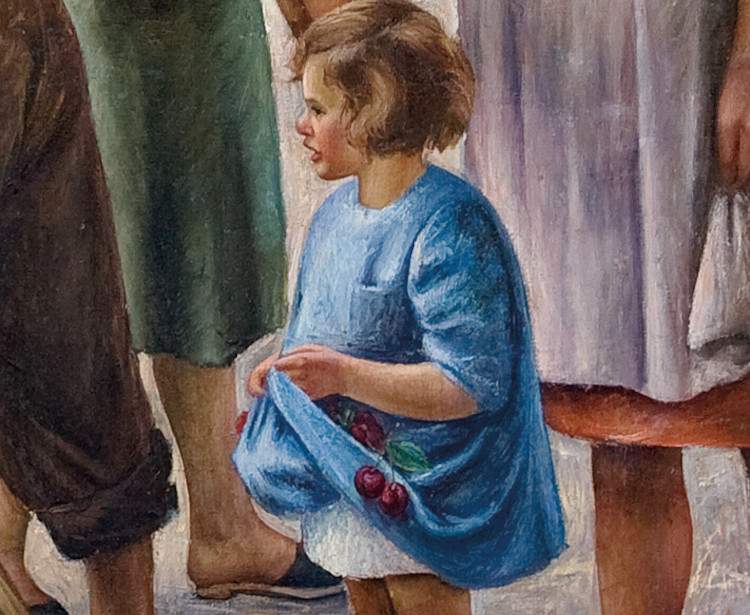From March 12 to May 8, 2022, the Palazzo delle Esposizioni of the Fondazione Banca del Monte di Lucca presents the exhibition Alfredo Catarsini: from the Docks to the Gothic Line. Landscapes, Figures and Large Pictorial Compositions (1917 - 1945), a major retrospective dedicated to the Viareggio artist Alfredo Catarsini, curated by Rodolfo Bona with the collaboration of Claudia Menichini and Elena Martinelli and promoted by Fondazione Banca del Monte di Lucca, Fondazione Lucca Sviluppo and Fondazione Alfredo Catarsini 1899.
Eighty-two works, including oil paintings on various media and charcoal and India ink drawings, will be on display to trace the first thirty years of the artist’s career. In particular, the exhibition intends to retrace the main stages that, from his beginnings in Viareggio on the banks of the Darsena, led him to the national art exhibitions of Fascist Italy, during the 1930s, to the realization of theViareggio fresco of 1936 and, in 1944-45 to the realization of the cycle of frescoes of San Martino in Freddana and Castagnori during the period of displacement in Lucchesia. A journey that began at the end of the second decade of the twentieth century, in the contained dimensions of the landscape or portrait painting, to arrive at the great compositions with historical, sacred and celebratory subjects that will be visible in the exhibition through a video.
In the selection made by the curator there are many works that have never been seen, some known only because they were published in printed texts and others that are returning after a period of oblivion. These include Alfredo Catarsini’sSelf-Portrait of 1934, donated in 2005 to the Uffizi Galleries; The Grain of the Lucca Reclamation, the large painting that took part in the 1940 Cremona Prize and was recently tracked down in Grosseto; and the small Veliero oreggiato, which dates back to 1917 and is therefore the oldest work so far found in the exhibition. For the first time, seven of the eight drawings from the period of displacement that in the late 1960s illustrated Catarsini’s novel Giorni neri (Black Days ), recently reprinted by La nave di Teseo, will be on view in their originals; finally, it will be possible to admire Donne nel rifugio antiaereo, the painting with which Catarsini participated in the XXIII Venice Biennale in 1942 and which, together with a sketch and two preparatory drawings, is being exhibited for the first time after so many years since it was recently traced.
The exhibition is divided into nine rooms on three floors of the Palazzo delle Esposizioni. On the ground floor is a first introductory room with a Self-Portrait that is part, with three other works on display, of the thirty works that his children Mity and Orazio Catarsini donated in 2001 to the Municipality of Viareggio and the large painting of the Cremona Prize; on the second floor there will be views of docks, seascapes and some drawings; on the second and more articulated floor will instead feature country landscapes, portraits, self-portraits, including the 1934 one lent by the Uffizi Gallery, family images, alongside works dedicated to the themes of war and religion, drawings and preparatory paintings for the frescoes of the Churches of San Martino in Freddana and Castagnori where Catarsini was displaced, and again drawings and paintings dedicated to air-raid shelters, images of Bastia where the artist stayed and exhibited in the 1930s, and some still lifes.
Two video stations will show through images, some also from the Teche Rai archive, the frescoes, from the earliest in Viareggio and those in San Martino in Freddana and Castagnori, and a selection of documents, photos, catalogs, and manuscripts from the period that are part of Catarsini’s Historical Archive, constantly updated by the Foundation, currently kept in the spaces of the Villa Museo Paolina Bonaparte in Viareggio, where it can be consulted and visited along with his atelier, reconstructed in great detail in 2003.
By connecting to the website www.fondazionecatarsini.com it will also be possible to visit the exhibition remotely.
Hours: Thursday and Friday from 3:30 to 7:30 p.m.; Saturday and Sunday from 10 a.m. to noon and 3:30 to 7:30 p.m. Closed Sunday, April 17 and May 1.
Free admission.
Image: Alfredo Catarsini, The grain of Lucca’s reclamation, detail (1940)
 |
| Lucca dedicates a major retrospective to Alfredo Catarsini on the first 30 years of his career |
Warning: the translation into English of the original Italian article was created using automatic tools. We undertake to review all articles, but we do not guarantee the total absence of inaccuracies in the translation due to the program. You can find the original by clicking on the ITA button. If you find any mistake,please contact us.